Ontario Brown Trout

Fishing For Ontario Brown Trout
As one of the top river guides in Ontario, I specialize in fishing for Ontario brown trout and they are my favorite trout species to fish for. Ontario brown trout can be a tough fish to catch for a few reasons and the information on this page can help you catch more Ontario Brown trout.
The Ontario brown trout is a popular trout species for Ontario anglers because they are found in many rivers and they grow bigger than other trout. Anglers can fish for Ontario brown with fly fishing, float fishing, and spin fishing. Most southern Ontario rivers have self-sustaining populations of brown trout.
Unlike brook trout, catching brown trout over 20 inches is not that uncommon if you know what you are doing and I will discuss some methods and tactics for catching more and bigger brown trout on this page.
The average size brown trout in Ontario rivers is 8 to 10 inches but there are some up to 30 inches and 10 pounds.
Brown trout which are also known as just browns by some of the locals are not native to Ontario. They were introduced from European brown trout strains around 1913.
Ontario Brown trout are now considered a naturalized fish which means they were once introduced and they now survive and reproduce naturally in our rivers.
Ontario Brown trout tend to be bigger than other trout species which is why many anglers like to target them.
Ontario brown trout can be the weariest and most difficult of all the trout species in Ontario and they can be a challenge for many anglers.
BROWN TROUT FOOD

Brown Trout Food: Brown trout in rivers can feed on almost anything that is alive in the river but their main food sources include river insects, small fish, crayfish, leeches, and worms.
Bigger brown trout sometimes prefer other fish as their main food source and have been known to even eat mice or small birds that have fallen into the river.
Many people think of trout as the fish that gently eats small insects off the surface but brown trout can be very aggressive and smash a well-presented lure or streamer fly.
We’ve had brown trout try and eat other trout as we reel them in. This little rainbow in the picture took the fly of an angler when a big 22″ brown trout grabbed and tried to eat the rainbow eventually letting the rainbow go.
BEST ONTARIO BROWN TROUT RIVERS

If you want to start catching more brown trout in Ontario you will need to know where to go.
There are many brown trout rivers and creeks in southern Ontario for anglers to explore and because brown trout can survive in warmer water than brook trout brown trout can often be found in the larger middle sections of the rivers where brook trout cant survive.
Brown trout also like smaller creeks and tributaries where the water stays cold and clean year-round.
On a report that I saw online, the OMNR website said that there were 159 brown trout rivers and streams in Ontario and most of those were in Southern Ontario. Because there are so many rivers and creeks I’m only listing the main brown trout rivers.
The best thing to do if you are interested in fishing for Ontario brown trout in other rivers is to go to my page The Best Rivers In Ontario For Trout And Steelhead and look those rivers over and start at the uppermost sections of any of them that are public access. There are some good brown trout rivers very near to Toronto.

Many of the best rivers for fishing for Ontario Brown Trout are within a 90 minutes drive of Toronto.
It’s worth exploring the middle and upper sections and the small creeks flowing into these rivers:
- Grand River
- Eramosa River
- Whitemans Creek
- Duffins Creek
- Bowmanville creek
- Ganaraska River
- Cobourg Creek
- Humber River
- Rouge River
- Credit River
- Bronte Creek
- Saugeen River and Tributaries
- Nottawasaga River and Tributaries
- Beaver River
- Bighead River
Migratory Brown Trout And Resident Brown Trout

Ontario has both migratory brown trout and resident Brown trout. A resident brown trout will remain in the rivers throughout their entire lifespan without migrating to one of the great lakes.
Many of the little creeks that enter the rivers could have populations of brown trout in them.
Although the smaller tributaries may be overgrown and difficult to fish many anglers prefer some of the bigger sections of rivers like you would find on the Grand River, or on the Credit River, and Saugeen Rivers simply because they are easier to fish.
BROWN TROUT HABITAT

Brown Trout Habitat: Ontario brown trout can be found throughout the river, in the middle, off to the sides, in deeper slower water, and even in shallower faster water.
On some of the bigger rivers like the one in the picture, it’s common to find them anywhere there is a break in the current or a slight increase in depth.
Brown trout require some flow to bring them cool oxygenated water, food, and cover or security where they can get away from any danger. Brown trout will hold in different sections of the river at different times and it’s not uncommon to see big brown trout feeding in water as shallow as 10 to 20 inches.
As with most trout, they are often found in seams and current breaks where there is a concentration of food flowing past them. They also like some depth or cover to offer them some security.

Brown trout will also use rocks, logs, and trees as cover, and the biggest ones are usually found near log jams or deeper water.
Ontario brown trout can also be found in slow-moving sections of rivers sipping on floating bugs or chasing minnows or crawfish in the rocks. Later in the summer months, big brown trout can also be found in fast pocket water because it is well oxygenated and has a steady stream of food.
Last year, the guides at A Perfect Drift Guide Company caught most of their large brown trout in water 2 feet or less.

When Does Trout Season Open In Ontario

In Southern Ontario where most brown trout exist, the Ontario Trout Season is from the 4th Saturday in April to September 30th. Northern Ontario does not have many brown trout rivers and in some Ontario fishing zones, the brown trout season is open all year.
There are a few exceptions where brown trout fishing is open until December 31st, and some sections of the river where brown trout is open all year, but for the most part, all brown trout sections are closed after September 30th. Make sure you check the Ontario fishing regulations before you go.
For more information and the full OMNR fishing regulations check out the OMNR website . At the time of writing this Southern Ontario is listed under zone 16 and some rivers we cover are under zone 17 in the OMNR Fishing Regulations.
Some sections of some rivers may also have different open seasons or may have special regulations like being barbless hook areas or catch and release only areas, so before going fishing be sure to look up the OMNR fishing regulations and look up the river you plan to fish first under the ” Exceptions to zone 16 or 17 regulations” section.
BEST TIME TO FISH BROWN TROUT IN ONTARIO

Prime Time: The best time to fish for brown trout on most rivers is from opening day in April or early May and throughout the month of June with sporadic to good fishing from July until the end of September depending on the water temperatures.
The guides at A Perfect Drift Guide Company teach anglers how to catch a lot of big brown trout during the summer months because they know where the coldest brown trout rivers are. As long as the river is below 68C it can be good brown trout fishing.
There are certain methods that also work better in the summer and early fall after the Ontario brown trout have been heavily pressured in the spring. A good guide can teach you these methods which will help you catch more and bigger brown trout.
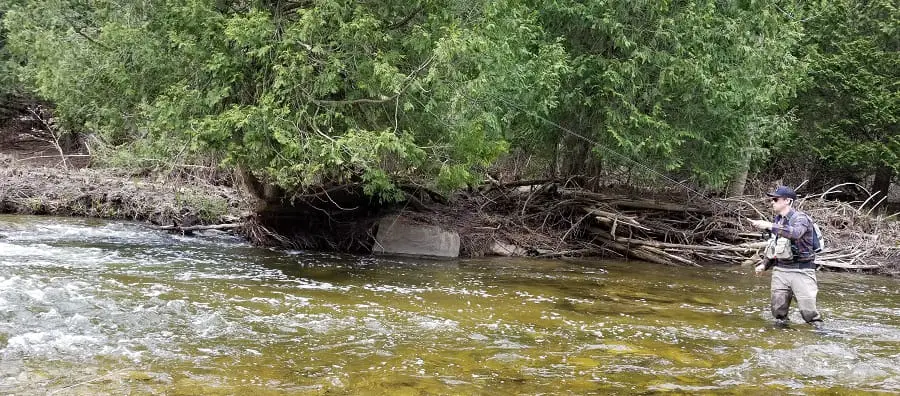
Some of the best brown trout fishing is also in the summer because there are a lot fewer anglers on the river pressuring the fish. The fishing for Ontario brown trout can stay good right up until the season end on September 30th.

Migratory brown trout anglers can start targeting them in early September but on many rivers, they peak later in October and early November.
I have done very well in December as the big migratory brown trout have finished their spawn and are starting to work their way back to the lake.
On some rivers, the big brown trout will hold over and slowly drop back to the lake throughout the winter months and even through the spring.
Migratory Ontario brown trout can reach sizes over 30 pounds and although migratory browns are not that plentiful if you get there on the right days it’s possible to catch a few.
TEMPERATURES FOR BROWN TROUT

Temperatures: Brown trout tend to be most active at certain temperatures. The optimal temperature range for feeding is about 55 to 67°F (12 to 19 °C) but they can survive and be active from 35 to 68 °F (2 to 20 °C).
Even though the temperature may be in the perfect range there are times when a rising or lowering temperature may stop their activity and feeding.
One word of caution is to not fish for brown trout or brown trout above 68°F / 20 °C because doing so can seriously stress the fish out or even kill them during the fight.
During the later part of hot summer days check the water temperatures frequently because once the water temps get around 69F brown trout tend to stop feeding which is a good time to go find colder water or end your fishing for the day.
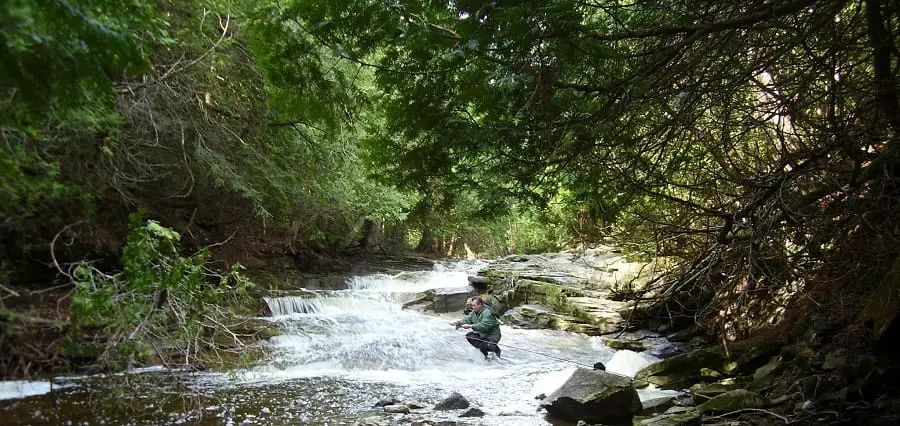
Some Ontario Brown trout rivers will stay colder than others so look for ones with lots of cold groundwater and lots of trees to shade the river from the sun.
How cold the river is will depend on how much groundwater is entering the river near where you fish, and also how much forest cover and shade there is where you are fishing and up the river.
HOW TO FISH FOR BROWN TROUT
Fishing Methods: The most common methods of fishing for brown trout include Fly fishing, Spin fishing with lures, or using floats and bait with a spinning reel or a bait caster, or even a Centerpin reel.
FLY FISHING FOR BROWN TROUT
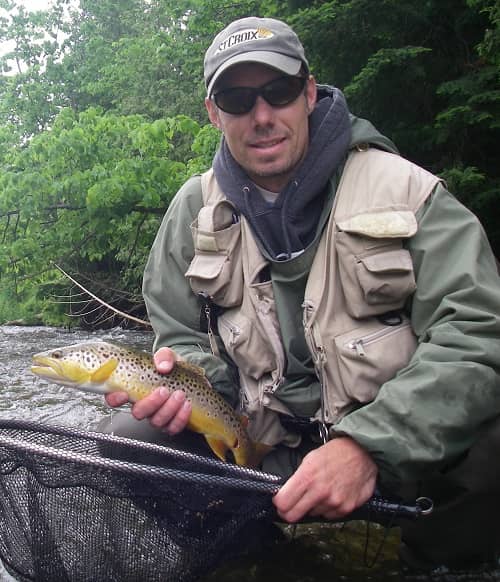
Fly Fishing: When fly fishing for brown trout we recommend that you use rods from 7 feet to 9 feet in the 3 weight to 5 weight sizes with a suitably matched reel and a floating line that is either a weight forward or double taper style.
For brown trout fishing, I prefer the Airflow Ridge lines for their high floatability and durability.
I also use the Scientific Anglers MPX fly lines.
Because the rivers and creeks are often on the smaller side and so are the fish it makes sense to keep things on the smaller lighter side.
Leaders like the Scientific Anglers Absolute Trout Tapered Leader in the 4x to 6x is recommended because brown trout can be line shy.
I don’t recommend a really heavy tippet line either since many of the rivers and creeks where brown trout are found are very clear water and the brown trout may see a very thick line. I use 5x and 6x RIO Powerflex Tippet when I am dry fly fishing and 5x and 6x RIO Fluoroflex Plus Tippet for Nymphing.
Going as light as possible on the tippet will help to get them to bite more and also prevent them from seeing the line.
But make sure your tippet is strong enough to enable you to get those bigger brown trout out of wooded areas once hooked. This is why I use a super-strong tippet like the RIO Fluoroflex Plus Tippet.
The tippet or leader diameter will also depend on the method I’m using at the time.
DRY FLY FISHING FOR BROWN TROUT

Dry Fly: Dry fly fishing for brown trout can be a lot of fun since they are sometimes quite eager to come to the surface.
I use traditional dead drift methods but will sometimes have more success using skittering techniques or a dry dropper method.
For more information or to learn how to do all the various dry fly techniques consider a lesson or guided trip with A Perfect Drift Guide Company.
For common dead drift dry fly methods check out this dry fly fishing video from my friends at The New Fly Fishing TV show.
Favorite Flies: Some of my favorite flies include:
- Royal Coachman dry fly and wet
- Humpy dry fly with yellow, orange, or red belly
- Orange Raven dry fly – See fly HERE
NYMPH FISHING FOR BROWN TROUT

Nymphing: It is said over 90% of the time trout feed on insects below the surface and this makes nymphing one of the most productive methods.
The most common nymphing method often includes a strike indicator or float with some split shot/weights and a fly called a nymph or wet fly.
Watch the video on how to do indicator nymph fishing for more information.
There are over 6 methods of nymphing and some methods work better than others under different river types and different conditions. The indicator style of nymphing is the most common method because it works but that doesn’t necessarily mean it’s the best or most productive method for trout in Ontario.
For more advanced and productive methods and productive flies consider booking into the Advanced Nymphing class or booking a guide trip from A Perfect Drift Guide Company.

Their reputation for using modern style nymphing has produced many fish like the ones below and has helped out hundreds of anglers catch more and bigger trout.
They have many customers that have landed between 3 and 6 brown trout over 20 inches in one day using their advanced nymphing methods.
WET FLY AND STREAMER FISHING FOR BROWN TROUT

Wet Fly and Streamer Fishing: Another productive and fun fly fishing method is wet fly fishing or streamer fishing.
Traditional wet fly fishing is using a swing style retrieve where you cast across and slightly downstream and with a tight line just let the fly swing across the pool until it’s directly below you or out of the main current or target zone.
For more advanced wet fly fishing consider a lesson or guide trip with A Perfect Drift Guide Company. You can also check out this video on wet fly swing fishing.
Streamer fishing can be productive and may produce the largest brown trout in the river.
There are multiple ways to use a streamer but the most common method is to cast across and slightly downriver and retrieving the streamer fly by stripping in the line with short steady pulls until the line is out of the target zone or you fully retrieve the line.
Check out this Streamer Fishing Video. For more advanced streamer fishing and multiple streamer methods and flies consider a lesson or guide trip with A Perfect Drift Guide Company.
GOOD FISHING FOR BROWN TROUT
The Good: The good thing right now is we do have some good opportunities for resident wild brown trout and just about every river system still has some brown trout in it for anglers to pursue.
Ontario brown trout are also relatively easy to catch using a variety of methods from spinning gear to fly rods and because of this they can be a great fish to introduce young kids to.
Both the number of rivers containing brown trout and the ease of catching them allows anglers in the know the opportunity to catch these beautiful fish during the open season.
RIVER ACCESS
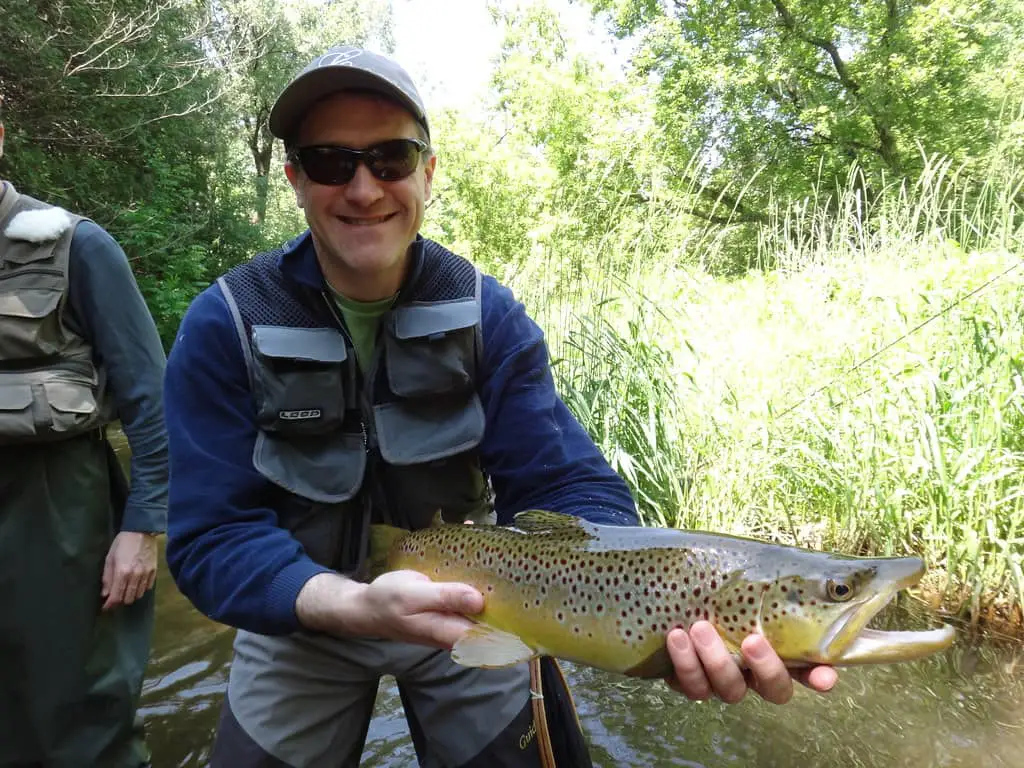
Access: Yes, I did say there are lots of brown trout rivers in Southern Ontario but because Ontario brown trout are often found in the coldest cleanest sections of a river, that usually limits them to only the upper most reaches of most rivers.
These upper sections can have poor fishing accessing due to lots of private property or hard-to-fish conditions like a thick overgrown bush.
Most rivers that I know of have only limited access to very small sections, or under bridges or the odd conservation area or a park area to fish, and these public areas often get heavily fished and many of big fish get fished out from angler that keeps them which makes for tough and poor fishing.
BIG ONTARIO BROWN TROUT
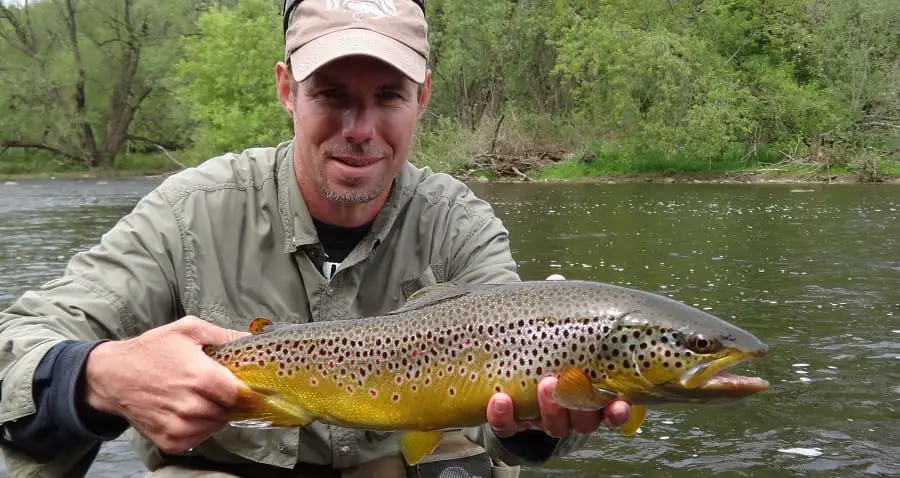
Size and Numbers: Because brown trout are relatively easy to catch and because in many rivers the legal possession limit is five there are not many opportunities for larger fish which in my opinion is primarily due to anglers keeping any fish big enough for the frying pan.
This leaves mostly small fish in the public sections of rivers and often means fewer numbers of big fish.
In my opinion, the only way this will ever get better is if anglers practice 100% catch and release or the OMNR lowers the catch limits and increases angling opportunities by securing more stretches of river to spread out the angling pressure.
RIVER ENFORCEMENT

Enforcement: I’d agree that more enforcement is required on Ontario rivers as poaching, out-of-season fishing and over harvest still occurs and accounts for poor fishing in some areas.
If you see someone breaking the law and hurting our fishery you can report illegal activity and you can call: The Ministry of Natural Resources and Forestry TIPS line at: 1-877-847-7667 Crime Stoppers (anonymous) 1-800-222-TIPS (8477) More information on how to report a crime: Go to the ONMRF website
BETTER BROWN TROUT FISHING
Better Brown Trout Fishing: Unfortunately our OMNR doesn’t recognize brown trout as a preferred trout because they are not a native trout and in the recent past it seems as though brown trout on most rivers don’t get much help.
The OMNR has placed a lot more emphasis is on native species like brook trout and Atlantic Salmon and because of this the OMNR has even proposed the killing off of brown trout in some rivers to expand their brook trout and Atlantic salmon programs.
Unfortunately, our environment is not getting any colder or cleaner and studies show that brook trout in many parts of the world are disappearing. It is my opinion that Brown trout are a lot more temperature and pollution tolerant and have the ability to survive better in many sections of our Ontario rivers and therefore should be considered as a better alternative species to focus on instead of being killed off by ignorant Ontario biologists with an agenda.
If better river fishing is important to you, I would highly recommend you contact the closest Trout Unlimited and join the fight to save our rivers and contact the closest OMNR office to you and let them know you want more brown trout and not less.
Other organizations helping keep our rivers good include:






